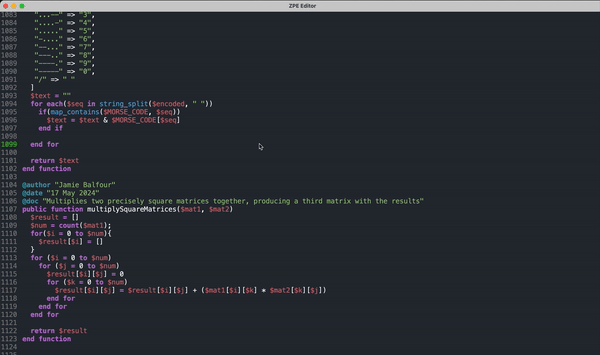The latest version of ZPE brings many changes that improve its performance while adding new and additional features to make the language even easier to work with.
Let's start with that, then. ZPE introduces function tooltips that allow you to hover over a function within the code and read a quick overview of that function, its parameters, and its return type(s).

The latest version also adds support for $-unbound parameters within function definitions, changes the way objects are passed across (they are always by reference, never copied), and changes the underlying ZPE class to the ZPEMain class and the ZPE class, separating logic from the startup features.
There's also a new internal object for Pairs and the function keyword that has been used for declaring a function type is now separate and is fn.
It's been a long time (nine years) since I posted my last YouTube video review, so I think it's time for me to return. This time, I will focus on software and web development tutorials.
But I'm also going to livestream again. I'm aiming to rebuild my YouTube account, so if you're interested, you can follow my channel at balf.io/youtube.
Since moving to my current house three and a half years ago, I have done many things to improve my home's technology.
I love my house; it's just perfect for me. It's close to work, in a place I always loved growing up, and somewhere I've known since I was a kid. That's why I've worked hard to improve my home more and more, and thanks to Colin coming round to assist me the other day, I've been able to tidy up the front cupboard finally (whilst I do know how to wire an RJ45 keystone and put cables through the wall, my good friend Colin is far more experienced).
But now, the next big thing I've been planning is upgrading the house to at least 2.5Gbe, as it makes no sense now that I have a fibre connection providing 1.6Gbps. After 1.6Gbps, the next upgrade is 2.2Gbps, so I'd need to consider this the last upgrade available on 2.5Gbe. The solution for computers is easy since most computers I own have a Thunderbolt port capable of up to 10Gbps at the minimum, though most are 40Gbps Thunderbolt 3 or Thunderbolt 4. I also have some computers that have 2.5Gbe on them.
For me, this means ensuring that all cables are at least CAT6a around the house, updating the router (out of my hands at the moment) and ensuring all my switches are cable of 2.5Gbe.
I will continue to update my followers with what happens out of this.
When I first started blogging in 2009, I was asked if HDMI could accept input and output over the same connector (not precisely at the same time). Of course, a graphics card with an HDMI port on it is most likely only for video output and not video input. Of course, the answer, therefore, was no.
But why not?
Well, the answer is that it's just not been implemented. That's because HDMI was never designed this way. Usually, when a connector (such as USB-C) is bidirectional, a handshake protocol is implemented that decides the connector's data flow.
Some features of HDMI, like Audio Return Channel (ARC) and Consumer Electronics Control (CEC), are, of course, bidirectional; for CEC, for example, the device can control a TV, and the TV can also control the device, and for ARC, the audio can be sent back to the device.
When I chilled out today, I realised that building multiple return values into ZPE would be easier than I thought.
That's because the new tuple syntax already works with that. So, without further ado, the latest version of YASS, YASS 24.10, supports the new multiple return values syntax:
function multiReturn() return 1, 3, 5 end function ($x, $y, $z) = multiReturn()
YASS 24.10 may be one of the final updates to the YASS language for a while. That's because its syntax is pretty perfect now.
I'm excited by what multiple return values brings to the YASS language.
Last week, I came across a potential means to add AI support to ZPE. This AI support could lead to better error reporting, code generation in the editor, syntax checking, or perhaps even for use within code.
I wanted to use this post to state that this is potentially on the cards.
The title, "I'm happiest when I'm in my IDE", isn't entirely accurate, but my IDE means a lot to me.
Thanks to a friend, my love was recently rekindled for IntelliJ IDEA again. I used it briefly while at university and loved it, but then I remembered that I had an edition that allowed me to use it as a student. Since I am no longer a student, I could not acquire that version and stuck with the Eclipse IDE for my Java programming, Visual Studio for C#, Visual Studio Code for Python and Atom/Pulsar for web development.
Atom and Pulsar are lovely editors with many features that I love. Visual Studio is the editor I have been using for the longest since the first language I learned, which I still actively use, was C#. Visual Studio Code has always been one of my favourite IDEs, but it lacks many of what other editors offer. Eclipse, however, is very dated, and whilst it does the job, it lacks a lot.
JetBrains IDEs, on the other hand, offer the best of everything. This is where the title of the post makes sense. I genuinely am happiest with the JetBrains suite of IDEs because the IDE I'm working with affects how I feel when writing code. And I say that because there are so many great things in them.
Take IntelliJ, for example. I put ZPE's code into IntelliJ, which has reshaped it. IntelliJ has shown me areas in which I can improve my code, for example, by replacing length == 0 with isEmpty(), or removing unnecessary assignments or variable initialisation when the variable gets initialised immediately after declaration.

My IDE means a lot to me, and I've heard the same from other programmers who also believe it affects your mental health whilst you are working. I decided just to do what I've been contemplating for a while and bought the JetBrains suite for the first time.
ZPE 1.12.9 is one of the most significant updates to ZPE since it started. It completes the major project of making all internal data types as instances of ZPEType, rather than relying on lower-level and abstract data types. This update is so significant because it now means higher performance due to less casting, better safety and ensuring that non-ZPEType values can no longer be injected into the program.
Further to this, new syntax features include the use of colon terminated conditions and for parameters:
while $x < 100:
print($x)
end while
Tuples are another feature of ZPE 1.12.9; they are different from class instances and objects entirely in that they are defined once but follow such a structure throughout their lifetime:
$x = (string, number, number)
$x = ("Hello world", 13, 7)
The new REQUIRE_EXPLICIT_VARIABLE_DECLARATION property and the requires_explicit_declaration directive both enforce that the user defines variables before they are used. This is a significant feature, which might become the default option in ZPE later on.
Finally, ZPE's editor has undergone a bit of overhaul. The icon is scaled down to look much smarter and suitable in internal windows and alert popups, whilst on macOS the logo used around the application is the logo found on the Dock. The scrollbars have been enhanced, too. And toggling dark mode now retains the position you were at when you toggled it. The final significant thing is that the console now runs in a separate process and can be stopped in between running a program, meaning if an infinite loop starts in the code, it will not affect the main editor. This will also come to my SQARL editor, which has also received a considerable number of improvements, including an icon at last.
ZPE 1.12.9 is now available to download from the usual place.
For an extremely long time, ZPE has relied on native Object types for return values. I never wanted to keep this because it meant a lot of type casting, type inference, potential bugs, a lack of security regarding what was passed around ZPE, and also a lot of type checking. This slowed down ZPE and meant it didn't feel particularly stable.
As of version 1.12.9, ZPE is now fully locked down to the ZPEType return type, which includes ZPEStrings, ZPENumbers, ZPEBooleans, ZPEObjects, ZPEFunctions, ZPERecords, ZPETuples, ZPELists, ZPEArrays, ZPEMaps, and ZPEOrderedMaps. This reduces ZPE's flexibility, making the Core much more stable.
As I say, this is one of the biggest updates to ZPE in a long time and it paves the way to further updates that will strengthen this.
What's really cool about this update, nothing has changed in the compiler so no scripts that have been compiled need to be changed, and in fact, nothing needs to be changed in any existing scripts.
ZPE 1.12.9 features a few major changes and improvements, but one stands out more than the others: the introduction of explicit variable declaration.
Explicit variable declaration means that variables must be declared before they are used, either in an assignment or for anything else. For example, if a variable $x isn't defined first, the compiler will detect this and throw an error.
$x = 15
will throw an error, whereas
number $x = 0
$x = 15
will not.
In addition, ZPE gets closer to having all underlying data types as ZPETypes. This will enforce the fact that things like plugins can only return types that ZPE itself controls, which will lead to better type safety. As of ZPE 1.12.9, we now have the ZPENumber data type underneath. It took me a whopping 8 hours to bring it to ZPE, and the implementation isn't complete yet. Further, I aim to improve the way the ZPEString is managed so that fewer checks need to be done with them as well.


